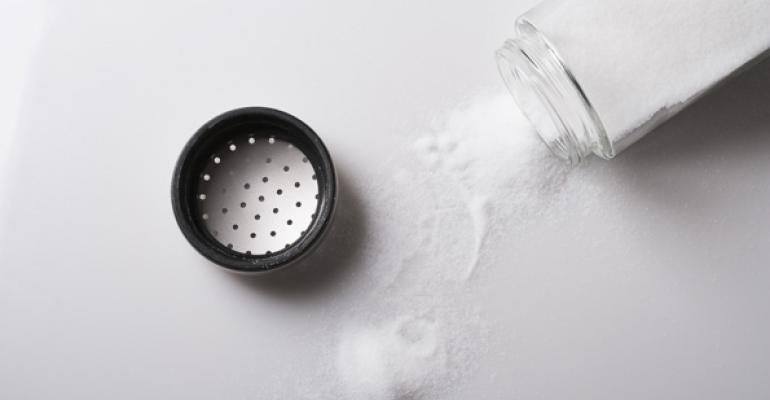
Trumping the top-of-mind menu labeling legislation, the New York City Board of Health pushed a first ever sodium regulation in record time. Passed on Sept. 9, 2015, with a compliance date of Dec. 1, 2015, this new amendment to the New York City Health Code is slated to affect about 3,000 restaurant locations from hundreds of nationwide brands. Restaurants doing business in New York City with 15 or more locations nationwide will be required to add a high sodium warning label to menus and menu boards, identifying food items that contain 2,300 mg of sodium or more.
The icon must be a black and white triangle “as wide as it is tall and equal in height to the largest letter in the food item’s name, as displayed on the menu, menu board, or tag next to any food on display.”
Additionally, this warning statement must be posted “conspicuously.”
“Warning: ![]() indicates that the sodium (salt) content of this item is higher than the total daily recommended limit (2300 mg). High sodium intake can increase blood pressure and risk of heart disease and stroke.”
indicates that the sodium (salt) content of this item is higher than the total daily recommended limit (2300 mg). High sodium intake can increase blood pressure and risk of heart disease and stroke.”
That’s right — Dec. 1, 2015. And it’s likely this development will spread nationwide. Read the rules here.
 Why 2,300 mg of sodium?
Why 2,300 mg of sodium?
Heart disease is the number one cause of death worldwide. High blood pressure, directly related to sodium intake in most people, is a major heart risk factor — and a largely preventable one. The American Heart Association (AHA) states that one-third of American adults have high blood pressure, and 90 percent of American adults are expected to develop high blood pressure over their lifetimes, greatly increasing the risk of heart disease. High blood pressure (or hypertension) is called the “silent killer” because there are generally no signs or symptoms. So it is important that everyone tracks his/her blood pressure throughout one’s lifetime. Do you know your blood pressure? Generally, a blood pressure level of 120/80 or below has been considered healthy.
According to the AHA, research suggests that if Americans reduced average intake of sodium to 1,500 mg/day, “It could result in a 25.6 percent overall decrease in blood pressure and an estimated $26.2 billion in health care savings,” and this goal would “reduce deaths from cardiovascular disease by anywhere from 500,000 to nearly 1.2 million over the next 10 years.”
The recommended amount of sodium for a day’s intake is 2,300 mg, except for African Americans, those aged 51 and above, and those with conditions like heart disease and kidney disease, who are all generally advised to limit intake to 1,500 mg per day. So the New York City Board of Health was not being unrealistic in setting the warning level at 2,300 mg — and in fact — some health groups were advocating for lower levels for the sodium warning symbol, even down to 500 mg of sodium.
Just say no
Save money and time, and prevent the risk of disappointed guests, by saying NO to the icon and making sure that most — if not all — of your menu items contain under 2,300 mg of sodium. It’s possible! We are in an era where growing numbers of Americans want to eat for health and are concerned about sodium. This regulation is likely to spread to other regions, so New York City can serve as a proof of concept demonstrating that your guests appreciate your efforts in making sure menu items are not alarmingly high in sodium.
Healthy Dining’s strategy proves guests prefer less sodium
Healthy Dining received funding from the National Cancer Institute, a division of the National Institutes of Health (NIH), to evaluate strategies to help restaurants reduce calories, saturated fat and sodium to levels that guests accept or not even notice. Healthy Dining’s registered dietitians and research team reduced salt and other high-sodium ingredients in several popular menu items at seven large restaurant chains and tested the menu items with more than 2,000 frequent restaurant customers.
The NIH-funded research was conducted by Healthy Dining in collaboration with research advisors, David L. Katz, MD, MPH, founding director of the Prevention Research Center at Yale University, Valentine Yanchou Njike, MD, MPH, assistant director of the Prevention Research Center at Yale University, and Harry Lawless, PhD, Professor Emeritus at Cornell University.
The Healthy Dining study focused on simply reducing the amounts of target ingredients — and not reformulating or adding additional ingredients — for popular menu items like burgers, seafood, pasta, soups and salads. The results show that almost every menu item with sodium levels reduced was rated as high as or higher than the original version in terms of flavor. The following table shows the current and modified (reduced sodium) overall flavor score and percentage of customers who indicated yes, definitely would or probably would order the menu item in the future.

Eleven out of 14 menu items with less sodium rated as high as or higher than the original versions in terms of flavor. Additionally, for most of the tested menu items, the restaurant guests were more likely to purchase the menu items with less sodium.

How will your restaurant respond to new nutritional guidelines? Join the conversation in the comments below.
It’s important to note that the taste testers did not know that the sodium had been reduced and did not know they were testing and rating the item for a nutrition-related study. The taste testers were recruited from restaurant guest lists and were not biased for health concerns or interest. These results can give restaurants and food suppliers confidence about efforts to reduce sodium.
"While there is debate about optimal levels of dietary sodium, there is no doubt that the typical American diet contains too much,” said David L. Katz, MD, MPH. “This research is demonstrating that sodium can be addressed while preserving good taste and enjoyment.”

